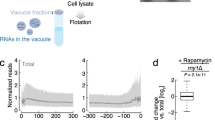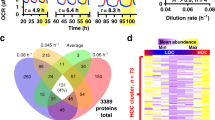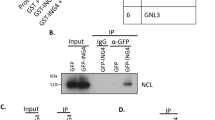Abstract
The target of rapamycin (TOR) signal-transduction pathway is an important mechanism by which eucaryotic cells adjust their protein biosynthetic capacity to nutrient availability. Both in yeast and in mammals, the TOR pathway regulates the synthesis of ribosomal components, including transcription and processing of pre-rRNA, expression of ribosomal proteins and the synthesis of 5S rRNA. Expression of the genes encoding the numerous constituents of ribosomes requires transcription by all three classes of nuclear RNA polymerases. In this review, we summarize recent advances in understanding the interplay among nutrient availability, transcriptional control and ribosome biogenesis. We focus on transcription in response to nutrients, detailing the relevant downstream targets of TOR in yeast and mammals. The critical role of TOR in linking environmental queues to ribosome biogenesis provides an efficient means by which cells alter their overall protein biosynthetic capacity.
This is a preview of subscription content, access via your institution
Access options
Subscribe to this journal
Receive 50 print issues and online access
$259.00 per year
only $5.18 per issue
Buy this article
- Purchase on Springer Link
- Instant access to full article PDF
Prices may be subject to local taxes which are calculated during checkout


Similar content being viewed by others
References
Barth-Baus D, Stratton CA, Parrott L, Myerson H, Meyuhas O, Templeton DJ et al. (2002). S6 phosphorylation-independent pathways regulate translation of 5′-terminal oligopyrimidine tract-containing mRNAs in differentiating hematopoietic cells. Nucl Acids Res 30: 1919–1928.
Beck T, Hall MN . (1999). The TOR signalling pathway controls nuclear localization of nutrient-regulated transcription factors. Nature 402: 689–692.
Bodem J, Dobreva G, Hoffmann-Rohrer U, Iben S, Zentgraf H, Delius H et al. (2000). TIF-IA, the factor mediating growth-dependent control of ribosomal RNA synthesis, is the mammalian homolog of yeast Rrn3p. EMBO Rep 1: 171–175.
Buttgereit D, Pflugfelder G, Grummt I . (1985). Growth-dependent regulation of rRNA synthesis is mediated by a transcription initiation factor (TIF-IA). Nucleic Acids Res 13: 8165–8180.
Cardenas ME, Cutler NS, Lorenz MC, Di Como CJ, Heitman J . (1999). The TOR signaling cascade regulates gene expression in response to nutrients. Genes Dev 13: 3271–3279.
Cavanaugh AH, Hirschler-Laszkiewicz I, Hu Q, Dundr M, Smink T, Misteli T et al. (2002). Rrn3 phosphorylation is a regulatory checkpoint for ribosome biogenesis. J Biol Chem 277: 27423–27432.
Claypool JA, French SL, Johzuka K, Eliason K, Vu L, Dodd JA et al. (2003). Tor pathway regulates Rrn3p-dependent recruitment of yeast RNA polymerase I to the promoter but does not participate in alteration of the number of active genes. Mol Cell Biol 15: 946–956.
Di Como CJ, Arndt KT . (1996). Nutrients, via the Tor proteins, stimulate the association of Tap42 with type 2A phosphatases. Genes Dev 10: 1904–1916.
Ferrari S, Manfredini R, Tagliafico E, Rossi E, Donelli A, Torelli G et al. (1990). Noncoordinated expression of S6, S11, and S14 ribosomal protein genes in leukemic blast cells. Cancer Res 50: 5825–5828.
Gingras AC, Raught B, Sonenberg N . (2001). Regulation of translation initiation by FRAP/mTOR. Genes Dev 15: 807–826.
Grummt I . (2003). Life on a planet of its own: regulation of RNA polymerase I transcription in the nucleolus. Genes Dev 17: 1691–1702.
Grummt I . (2006). Actin and myosin as transcription factors. Curr Opin Genet Dev 16: 191–196.
Grummt I, Smith VA, Grummt F . (1976). Amino acid starvation affects the initiation frequency of nucleolar RNA polymerase. Cell 7: 439–445.
Gstaiger M, Luke B, Hess D, Oakeley EJ, Wirbelauer C, Blondel M et al. (2003). Control of nutrient-sensitive transcription programs by the unconventional prefoldin URI. Science 302: 1208–1212.
Hannan KM, Brandenburger Y, Jenkins A, Sharkey K, Cavanaugh A, Rothblum L et al. (2003). mTOR-dependent regulation of ribosomal gene transcription requires S6K1 and is mediated by phosphorylation of the carboxy-terminal activation domain of the nucleolar transcription factor UBF. Mol Cell Biol 23: 8862–8877.
Hara K, Yonezawa K, Weng Q-P, Kozlowski MT, Belham C, Avruch J . (1998). Amino acid sufficiency and mTOR regulate p70 S6 kinase and eIF-4E BP1 through a common effector mechanism. J Biol Chem 273: 14484–14494.
Hardwick JS, Kuruvilla FG, Tong JK, Shamji AF, Schreiber SL . (1999). Rapamycin-modulated transcription defines the subset of nutrient-sensitive signaling pathways directly controlled by the Tor proteins. Proc Natl Acad Sci USA 96: 14866–14870.
Holland EC, Sonenberg N, Pandolfi PP, Thomas G . (2004). Signaling control of mRNA translation in cancer pathogenesis. Oncogene 23: 3138–3144.
Humphrey EL, Shamji AF, Bernstein BE, Schreiber SL . (2004). Rpd3p relocation mediates a transcriptional response to rapamycin in yeast. Chem Biol 11: 295–299.
Jacinto E, Loewith R, Schmidt A, Lin S, Ruegg MA, Hall A et al. (2004). Mammalian TOR complex 2 controls the actin cytoskeleton and is rapamycin insensitive. Nat Cell Biol 6: 1122–1128.
James MJ, Zomerdijk JC . (2004). Phosphatidylinositol 3-kinase and mTOR signaling pathways regulate RNA polymerase I transcription in response to IGF-1 and nutrients. J Biol Chem 279: 8911–8918.
Jefferies HB, Fumagalli S, Dennis PB, Reinhard C, Pearson RB, Thomas G . (1997). Rapamycin suppresses 5′TOP mRNA translation through inhibition of p70s6k. EMBO J 16: 3693–3704.
Jiang Y, Broach JR . (1999). Tor proteins and protein phosphatase 2A reciprocally regulate Tap42 in controlling cell growth in yeast. EMBO J 18: 2782–2792.
Jorgensen P, Rupes I, Sharom JR, Schneper L, Brouch JR, Tyers M . (2004). A dynamic transcriptional network communicates growth potential to ribosome synthesis and critical cell size. Genes Dev 18: 2491–2505.
Kim DH, Sarbassov DD, Ali SM, Latek RR, Guntur KV, Erdjument-Bromage H et al. (2003). GbetaL, a positive regulator of the rapamycin-sensitive pathway required for the nutrient-sensitive interaction between raptor and mTOR. Mol Cell 11: 895–904.
Kimball SR, Shantz LM, Horetsky RL, Jefferson LS . (1999). Leucine regulates translation of specific mRNAs in L6 myoblasts through mTOR-mediated changes in availability of eIF4E and phosphorylation of ribosomal protein S6. J Biol Chem 274: 11647–11652.
Laferté A, Favry E, Sentenac A, Riva M, Carles C, Chedin C . (2006). The transcriptional activity of RNA polymerase I is a key determinant for the level of all ribosome components. Genes Dev 20: 2030–2040.
Mahajan PB . (1994). Modulation of transcription of rRNA genes by rapamycin. Int J Immunopharmacol 16: 711–721.
Marion RM, Regev A, Segal E, Barash Y, Koller D, Friedman N et al. (2004). Sfp1 is a stress- and nutrient-sensitive regulator of ribosomal protein gene expression. Proc Natl Acad Sci USA 101: 14315–14322.
Martin DE, Soulard A, Hall MN . (2004). TOR regulates ribosomal protein gene expression via PKA and the Forkhead transcription factor FHL. Cell 119: 969–979.
Mayer C, Zhao J, Yuan X, Grummt I . (2004). mTOR-dependent activation of the transcription factor TIF-IA links rRNA synthesis to nutrient availability. Genes Dev 18: 423–434.
Miller G, Panov KI, Friedrich JK, Trinkle-Mulcahy L, Lamond AI, Zomerdijk JC . (2001). hRRN3 Is essential in the SL1-mediated recruitment of RNA polymerase I to rRNA gene promoters. EMBO J 20: 1373–1382.
Moorefield B, Greene EA, Reeder RH . (2000). RNA polymerase I transcription factor Rrn3 is functionally conserved between yeast and human. Proc Natl Acad Sci USA 97: 4724–4729.
Nader GA, McLoughlin TJ, Esser KA . (2005). mTOR function in skeletal muscle hypertrophy: increased ribosomal RNA via cell cycle regulators. Am J Physiol Cell Physiol 289: C1457–C1465.
Naora H, Takai I, Adachi M, Naora H . (1998). Altered cellular responses by varying expression of a ribosomal protein gene: sequential coordination of enhancement and suppression of ribosomal protein S3a gene expression induces apoptosis. J Cell Biol 141: 741–753.
Pende M, Um SH, Mieulet V, Sticker M, Goss VL, Mestan J et al. (2004). S6K1(−/−)/S6K2(−/−) mice exhibit perinatal lethality and rapamycin-sensitive 5′-terminal oligopyrimidine mRNA translation and reveal a mitogen-activated protein kinase-dependent S6 kinase pathway. Mol Cell Biol 24: 3112–3124.
Powers T, Walter P . (1999). Regulation of ribosome biogenesis by the rapamycin-sensitive TOR-signaling pathway in Saccharomyces cerevisiae. Mol Biol Cell 10: 987–1000.
Preiss T, Baron-Benhamou J, Ansorge W, Hentze MW . (2003). Homodirectional changes in transcriptome composition and mRNA translation induced by rapamycin and heat shock. Nat Struct Biol 10: 1039–1047.
Proud CG . (2002). Regulation of mammalian translation factors by nutrients. Eur J Biochem 269: 5338–5349.
Rohde J, Cardenas ME . (2003). The tor pathway regulates gene expression by linking nutrient sensing to histone acetylation. Mol Cell Biol 23: 629–635.
Rohde J, Heitman J, Cardenas ME . (2001). The TOR kinases link nutrient sensing to cell growth. J Biol Chem 276: 9583–9586.
Rudra D, Zhao Y, Warner JR . (2005). Central role of Ifh1p-Fhl1p interaction in the synthesis of yeast ribosomal proteins. EMBO J 24: 533–542.
Ruggero D, Pandolfi PP . (2003). Does the ribosome translate cancer? Nat Rev Cancer 3: 179–192.
Schawalder SB, Kabani M, Howald I, Choudhury U, Werner M, Shore D . (2004). Growth-regulated recruitment of the essential yeast ribosomal protein gene activator Ifh1. Nature 432: 1058–1061.
Schmelzle T, Hall MN . (2000). TOR, a central controller of cell growth. Cell 103: 253–262.
Tang H, Hornstein E, Stolovich M, Levy G, Livingstone M, Templeton D et al. (2001). Amino acid-induced translation of TOP mRNAs is fully dependent on phosphatidylinositol 3-kinase-mediated signaling, is partially inhibited by rapamycin, and is independent of S6K1 and rpS6 phosphorylation. Mol Cell Biol 21: 8671–8683.
Volarevic S, Thomas G . (2001). Role of S6 phosphorylation and S6 kinase in cell growth. Prog Nucl Acid Res Mol Biol 65: 101–127.
Warner JR . (1999). The economics of ribosome biosynthesis in yeast. Trends Biochem Sci 24: 437–440.
White RJ . (2005). RNA polymerases I and III, growth control and cancer. Nat Rev 6: 69–78.
Xu G, Kwon G, Cruz WS, Marshall CA, McDaniel ML . (2001). Metabolic regulation by leucine of translation initiation through the mTOR-signaling pathway by pancreatic beta-cells. Diabetes 50: 353–360.
Yuan X, Zhao J, Zentgraf H, Hofmann-Rohrer U, Grummt I. (2002). Multiple interactions between RNA polymerase I, TIF-IA, and TAFI subunits regulate preinitiation complex assembly at the ribosomal gene promoter. EMBO Rep 3: 1082–1087.
Zaragoza D, Ghavidel A, Heitman J, Schultz MC . (1998). Rapamycin induces the G0 program of transcriptional repression in yeast by interfering with the TOR signaling pathway. Mol Cell Biol 18: 4463–4470.
Acknowledgements
We apologize to those whose work was not cited or discussed because of space limitations. Work in the authors' laboratory is supported by the Deutsche Forschungsgemeinschaft (SFB/Transregio 5, SP, Epigenetics'), the EU-Network ‘Epigenome’ and the Fonds der Chemischen Industrie.
Author information
Authors and Affiliations
Corresponding author
Rights and permissions
About this article
Cite this article
Mayer, C., Grummt, I. Ribosome biogenesis and cell growth: mTOR coordinates transcription by all three classes of nuclear RNA polymerases. Oncogene 25, 6384–6391 (2006). https://doi.org/10.1038/sj.onc.1209883
Published:
Issue Date:
DOI: https://doi.org/10.1038/sj.onc.1209883
Keywords
This article is cited by
-
MiR-330-5p and miR-1270 target essential components of RNA polymerase I transcription and exhibit a novel tumor suppressor role in lung adenocarcinoma
Cancer Gene Therapy (2023)
-
The conserved RNA-binding protein Seb1 promotes cotranscriptional ribosomal RNA processing by controlling RNA polymerase I progression
Nature Communications (2023)
-
Increasing the number of ribosomal uL6 mRNA copies accelerates aging of the budding yeast
Molecular Biology Reports (2023)
-
Epigenetic Activation of Ribosomal Cystrons in Chromatids of Acrocentric Chromosome 15th in Ductal Breast Cancer
International Journal of Peptide Research and Therapeutics (2023)
-
Androgens increase excitatory neurogenic potential in human brain organoids
Nature (2022)



